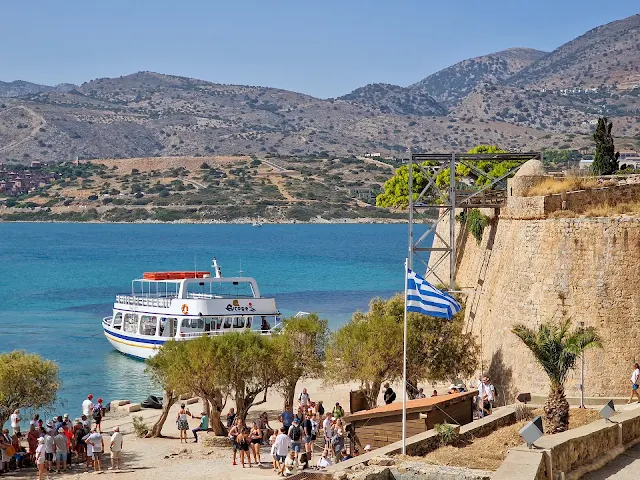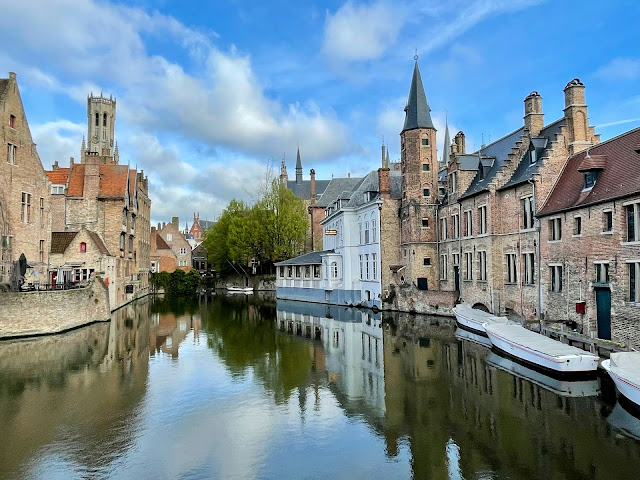Exploring the Treasures of Crete: A Journey through History, Nature and Culture
Crete is the largest and most populous of the Greek islands, and a popular destination for travelers who want to experience the rich culture, history, and natural beauty of this Mediterranean gem. Whether you are looking for a relaxing beach vacation, an adventurous outdoor adventure, or a cultural immersion, Crete has something for everyone.
 |
| Spinalonga Island, Agios Nikolaos, Greece |
Best things to do in Crete, Greece
- Visit the Palace of Knossos
This ancient site is the largest and most famous of the Minoan civilization, which flourished on Crete from about 2000 to 1400 BC. The palace is a complex of colorful frescoes, intricate architecture, and mysterious legends. You can explore the palace on your own or join a guided tour to learn more about the history and mythology of this fascinating place.
- Explore the Samaria Gorge
This is one of the longest and most spectacular gorges in Europe, stretching for 16 km from the Omalos Plateau to the Libyan Sea. The hike takes about 4 to 6 hours, depending on your pace and fitness level, and offers stunning views of the rugged landscape, lush vegetation, and wildlife. You will also pass by the abandoned village of Samaria, where you can see the old stone houses and churches. The hike ends at the coastal village of Agia Roumeli, where you can relax on the beach or take a boat to your next destination.
- Enjoy the beaches
Crete has some of the best beaches in Greece, ranging from sandy to pebbly, from crowded to secluded, from calm to windy. Some of the most popular beaches are Balos Lagoon, Elafonisi Beach, Vai Beach, Falassarna Beach, and Preveli Beach. You can swim, sunbathe, snorkel, surf, or just admire the turquoise waters and the scenic backdrops.
- Discover the Cretan cuisine
Crete is known for its delicious and healthy cuisine, which is based on fresh local ingredients, olive oil, herbs, cheese, honey, and wine. Some of the typical dishes are dakos (a salad of barley rusks topped with tomatoes, cheese, and oregano), kalitsounia (cheese or herb pies), boureki (a casserole of potatoes, zucchini, cheese, and mint), stifado (a stew of meat and onions), and loukoumades (fried dough balls with honey and nuts). You can also try the famous Cretan raki (a strong alcoholic drink made from grapes) or tsikoudia (a similar drink flavored with herbs).
- Experience the Cretan culture
Crete has a rich and diverse culture that reflects its long and turbulent history. You can visit some of the many museums, churches, monasteries, castles, and archaeological sites that showcase the different periods and influences that shaped Crete. You can also enjoy some of the traditional music, dance, art, and festivals that celebrate the Cretan identity and spirit. Some of the most famous events are the Carnival of Rethymno, the Renaissance Festival of Rethymno, the Chestnut Festival of Elos, and the Wine Festival of Dafnes.
Take a boat tour to Spinalonga Island
Located near the town of Elounda, Spinalonga is a small island with a fascinating history. It was once a Venetian fortress and later served as a leper colony in the early 20th century. Exploring the island, you can visit the well-preserved ruins of the fortress, walk through the abandoned streets, and learn about the lives of the lepers who once lived there. The boat ride to Spinalonga also offers beautiful views of the surrounding sea and coastline.
Visit the Archaeological Museum of Heraklion
Located in the capital city of Crete, this museum is home to an impressive collection of artifacts from the Minoan civilization and other ancient cultures that thrived on the island. You can admire intricate pottery, exquisite jewelry, ancient tools, and statues, including the famous Bull Leaping fresco. The museum provides valuable insights into the history and art of Crete, making it a must-visit for history buffs and archaeology enthusiasts.
Explore the charming old towns of Chania and Rethymno
Both Chania and Rethymno are picturesque towns that showcase the island's Venetian and Ottoman influences. Strolling through the narrow streets of their old quarters, you'll encounter colorful buildings, historic architecture, quaint shops, and traditional taverns. Don't miss the Venetian harbors in both towns, where you can enjoy a leisurely walk along the waterfront and soak up the atmosphere of the past.
Hike the White Mountains (Lefka Ori)
If you're an outdoor enthusiast, the White Mountains offer excellent hiking opportunities with breathtaking views. Mount Pachnes, the highest peak in the range, stands at an elevation of over 2,450 meters and offers a challenging but rewarding hike. There are also numerous trails of varying difficulty levels that lead you through dramatic landscapes, rugged canyons, and alpine meadows. Remember to bring proper hiking gear and check weather conditions before embarking on your adventure.
Visit the Arkadi Monastery
Located southeast of Rethymno, the Arkadi Monastery is not only a significant religious site but also a symbol of Cretan independence and resistance. It played a crucial role during the Cretan revolt against the Ottoman Empire in 1866. Today, the monastery stands as a peaceful retreat surrounded by picturesque gardens and Byzantine architecture. Inside, you can explore the church, admire the ornate frescoes, and visit the museum, which exhibits artifacts and relics from its tumultuous history.
Take a day trip to the island of Santorini
While technically not on Crete, Santorini is easily accessible by ferry and makes for a fantastic day trip. Famous for its iconic blue-domed churches, whitewashed buildings, and breathtaking sunsets, Santorini offers a unique and romantic atmosphere. Explore the charming villages of Oia and Fira, visit the ancient site of Akrotiri, relax on the volcanic beaches, and savor the local cuisine and wine.
Crete truly offers a diverse range of experiences, combining ancient history, natural beauty, and warm hospitality. Whether you're interested in archaeology, outdoor adventures, beach relaxation, or immersing yourself in Greek culture, Crete is sure to captivate you with its charm and allure.
Crete Beaches
Crete is renowned for its stunning beaches, offering a diverse range of coastal landscapes and crystal-clear waters. Here are some of the top beaches to explore during your visit to Crete:
Balos Lagoon: Located in the northwest region of Crete, Balos Lagoon is a picture-perfect beach with turquoise waters and pink-hued sand. Accessible by boat or a challenging hike, this secluded paradise is surrounded by dramatic cliffs and offers breathtaking views.
Elafonisi Beach: Situated in southwestern Crete, Elafonisi is famous for its pink sand and shallow, clear waters. The beach is part of a nature reserve and features a small islet that can be reached on foot during low tide, adding to the charm of this unique destination.
Vai Beach: Located on the eastern side of Crete, Vai Beach is renowned for its palm forest, one of the largest in Europe. The golden sand, crystal-clear waters, and the exotic atmosphere created by the palm trees make it a popular spot for relaxation and water sports.
Falassarna Beach: Positioned on the western coast of Crete, Falassarna Beach offers a long stretch of golden sand and stunning turquoise waters. With its Blue Flag status, this beach is not only visually appealing but also provides excellent facilities for visitors.
Preveli Beach: Nestled on the southern coast of Crete, Preveli Beach is a unique combination of a freshwater river and a sandy beach surrounded by lush palm trees. This idyllic setting offers a serene atmosphere for sunbathing and swimming in the crystal-clear waters.
Matala Beach: Situated in the village of Matala, this beach is famous for its remarkable rock formations, which feature ancient caves that were once used as homes and gathering places. Matala Beach has a bohemian vibe and is known for its hippie heritage.
Plakias Beach: Located on the southern coast of Crete, Plakias Beach offers a picturesque setting surrounded by rugged cliffs and mountains. The long sandy beach is ideal for sunbathing and swimming, while nearby taverns and cafes provide a relaxing beachside experience.
Agia Pelagia Beach: Situated on the northern coast of Crete, Agia Pelagia Beach is a popular destination known for its calm and clear waters. This organized beach offers various water sports activities, as well as beachfront restaurants and cafes.
Stalis Beach: Found in the resort town of Stalis, this long sandy beach offers a vibrant atmosphere with plenty of beach bars, water sports facilities, and sunbeds. It's an ideal spot for those seeking a lively beach experience.
Agiofarago Beach: Accessible by a scenic hike through a gorge, Agiofarago Beach offers a secluded and pristine setting. Surrounded by steep cliffs, this beach is a hidden gem for nature lovers and those looking for tranquility.
Whether you prefer secluded coves, vibrant resort beaches, or off-the-beaten-path hidden gems, Crete's beaches cater to every taste. Take your pick and enjoy the sun, sand, and sea during your visit to this captivating Greek island.
FAQs
What is the best time to visit Crete?
The best time to visit Crete is during the spring (April to June) and autumn (September to October) seasons when the weather is pleasant, and the tourist crowds are smaller. However, Crete can be enjoyed year-round, with summers being hot and dry and winters mild but with some rain.
How do I get to Crete?
Crete has two international airports, Heraklion Airport (HER) and Chania Airport (CHQ), which receive direct flights from various European cities. You can also reach Crete by ferry from Athens or other Greek islands.
Is it necessary to rent a car in Crete?
Renting a car in Crete is highly recommended as it provides the freedom to explore the island at your own pace, especially if you plan to visit remote beaches or venture into the mountains. However, there are also public transportation options, such as buses, that connect major towns and attractions.
Are there any specific cultural customs or etiquette to be aware of in Crete?
While visiting Crete, it's respectful to dress modestly when entering churches or monasteries. Additionally, it's common courtesy to greet locals with a friendly "Yassas" (hello) and "Efharisto" (thank you) when interacting with them. Respect for the island's cultural heritage and natural environment is always appreciated.
Are there any safety concerns for travelers in Crete?
Crete is generally considered a safe destination for travelers. However, it's always wise to take basic precautions, such as keeping an eye on your belongings, avoiding isolated areas at night, and following any local guidelines or advisories.
Can I use credit cards in Crete, or should I carry cash?
Credit cards are widely accepted in most establishments in Crete, including hotels, restaurants, and shops. However, it's advisable to carry some cash, especially in smaller villages or when visiting local markets or taverns that may prefer cash payments.
Are there any specific health considerations for travelers to Crete?
It's always recommended to have travel insurance that covers medical expenses while visiting Crete. It's also advisable to check if any specific vaccinations are required before traveling. Drinking tap water is generally safe, but if you prefer, bottled water is widely available.
Can I communicate in English in Crete?
English is widely spoken in tourist areas, hotels, and restaurants. However, learning a few basic Greek phrases can go a long way in enhancing your interactions and showing appreciation for the local culture.
Are there any specific customs or events that I should experience in Crete?
Attending a traditional Cretan music and dance performance, participating in a local festival, or trying a Cretan cooking class can provide immersive cultural experiences that showcase the island's vibrant traditions and customs.
Are there any additional fees or taxes to consider when visiting Crete?
In Greece, a hotel tax, commonly referred to as the "stayover tax," is charged per night per room. This tax varies depending on the official hotel category and can be paid directly to the accommodation upon check-in.



Comments
Post a Comment
It's easy to leave a comment on our blog – anyone with a Google account can do it. We invite you to share your experiences by leaving a comment as well.